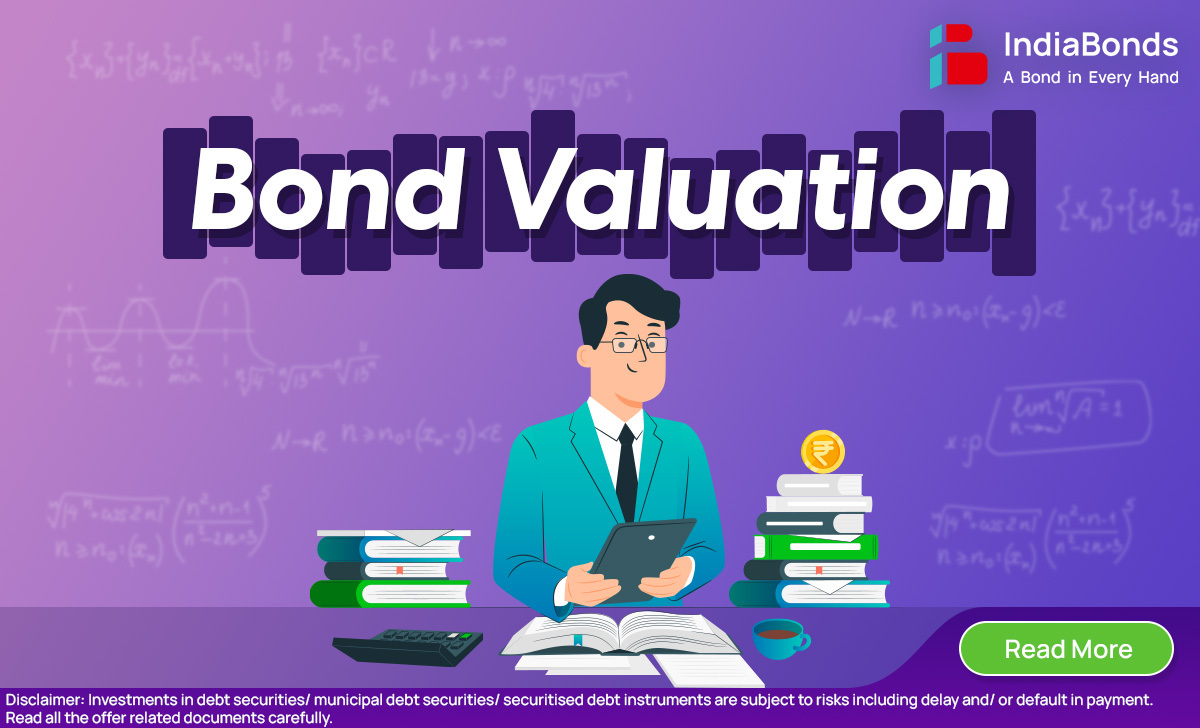
What comes to your mind when you hear the term ‘bond valuation’, do you immediately think of complex mathematical calculations or mind-boggling fixed-income concepts? When it comes to fixed-income securities or financial investments in general, we tend to shy away from concepts and strategies because they can be difficult to comprehend and what we don’t understand can be intimidating. However, fret not. In this unique two-part series, we will first explore the concept of what is bond valuation theoretically and then in part two ‘how to value a bond’ decode it with an example to help you grasp the entire idea of bond valuation. This gobbledygook–free write-up will help you cement the concept of valuation of bonds.
The notion of bond valuation primarily revolves around these two ideas; these coupled with a dash of economics fuels the world of bond investments.
1. Valuation
2. Time Value of Money – Discount Rate and Cash Flows
A concept familiar to Indians! We’ve all engaged in it at some point—whether bargaining for clothes, vegetables or even electronic goods—we haggle passionately, aiming to pay the minimum while squeezing out maximum value. Interestingly, the concept of valuing financial products is rooted in this principle. Financial assets can be valued at any given point, typically falling into two categories: market value and fair value. Market value is determined by the price or value at which an asset is traded in the market, influenced by demand and supply dynamics. On the other hand, fair value of the asset represents how much does the asset value on a given date.
When investing in financial products such as bonds or equities, the expectation is to receive returns, also known as future cash flows, over a period of time. As a bond investor, it’s important to figure out how much those future cash flows are worth to you today. This is because when you invest in bonds, you’re putting in money now expecting to receive future payments. The goal is to make sure you’re not paying too much upfront and ending up with less in return later on. This process of determining the present value of future cash flows is accomplished using the concept of Time Value of Money (TVM). TVM is a basic finance concept taught in every business school and is fundamental in the finance world.
Let me ask you a question: Would you prefer to have Rs 10,000 today or receive Rs 10,000 a year from now? It’s clear that you’d rather have Rs 10,000 now than later. You can save, spend or invest it. Money in hand now is more valuable than money in hand years from now and here are three reasons why:
Inflation: Have you ever heard older generations talk about how much they could buy with Rs 10? It’s hard to imagine now and that’s because of inflation. Over time, the value of currency decreases, which is known as monetary inflation.
Uncertainty: The future is unpredictable and risky. There’s no guarantee of future cash flows, making the money you have now more valuable.
Immediate Consumption: Generally, we prefer consuming something right now than future consumption due to instant gratification, hence to delay this immediate consumption one needs to offer more in the future this concept is popularly known as opportunity cost.
Let’s elaborate this concept of opportunity cost further by an example:
I need Rs. 1,00,000 from you to start my own pani-puri stall, but I can’t repay it now. I’ll only be able to pay it back after a year. But here’s the deal: I’ll pay you interest on the borrowed amount because I am using up the Rs. 1,00,000 that you could have spent, invested or saved today! ! You could have put that money in a fixed deposit and earned a straight 7%, but instead, you’re lending it to me, a total stranger! So, to compensate for that, I have to offer something extra. That’s why I suggest offering more than a fixed deposit. How about 10%? Now you’re paying attention and showing interest. But why 10%? This leads us to the idea of the discount rate!




The discount rate, also known as the required rate of return by the market varies depending on the types of bonds or simply types of cash flows involved, whether they are risky or risk-free. When you lend money for my pani puri business, there are risks involved, such as the possibility that the business may not succeed and I may not be able to make timely payments (default risk). However, when you lend money to the government by purchasing government securities, the cash flows are essentially risk-free because the government can print money and cover the debt in case of default. Therefore, you demand a higher risk premium for risky cash flows compared to risk-free ones, which is reflected in the discount rate. Hence, higher the risk higher the discount rate!
A business can’t function without cash flows and likewise, an investor won’t invest without them. No cash flow, no business; no cash flow, no investor. Cash flows address the fundamental question guiding the investment world: “What’s in it for me?” or, in essence, how much profit will I gain. In our previous example, the 10% on the principal of 100,000 which is Rs 10,000 is the cash flow I will pay you, in addition to the original investment. It’s important to note that since I’ve borrowed your money, regardless of whether my pani-puri business succeeds or not, I am obligated by contract to pay you this cash flow or interest income and that’s the beauty of fixed-income asset class. Stable, timely and consistent revenue.
These are the primary factors influencing bond valuation: time value of money, discount rate and cash flows. Simple, isn’t it? You can use these principles to figure out the fair value of an asset, like a bond in our case and see if investing in that bond is a good idea or not. In part two, we’ll put together everything we’ve learned to see how to value a bond.
A. Bond valuation is figuring out how much a bond is worth. It involves looking at things like the bond’s interest rate, when it matures and how risky it is. This helps investors decide if they want to buy, sell or hold onto the bond.
A. Time Value of Money means that having money now is better than having the same amount later because you can use it to make more money. TVM is fundamental in finance and investment, guiding decisions about saving, investing, borrowing and lending.
Disclaimer: Investments in debt securities/ municipal debt securities/ securitised debt instruments are subject to risks including delay and/ or default in payment. Read all the offer related documents carefully.